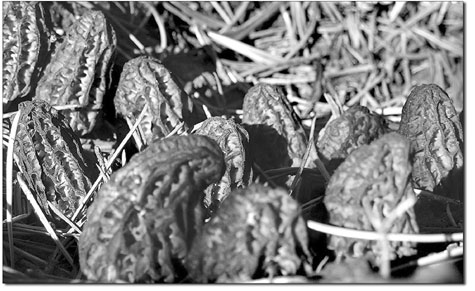| ||
Succumbing to fungal lust
by Chef Boy Ari Like any form of hunting, morel picking gets the juices flowing. The sight of your prey hits you, somehow standing out against a background painted in the same colors: ash black, spruce needle red, tree trunk brown and rock gray. Like the sight of a deer in a field, or the untracked line of a powder stash, or a babe across the room, you spot that distinct shape, sometimes out of the corner of your eye. In a bed of needles perhaps, or by a creek, or in a burnt-out stump hole, or even in lightly burned duff. The sight of the shape releases a shot of energy inside. Inexperienced hunters rush in, wide-eyed and goofy, tripping over whatever lies in their path – including other morels – and pick everything in sight. Experienced hunters know that not every morel is worth picking. Some are past their prime, waterlogged, or full of worms. By some deep programming, sharpened by millennia of evolution, the practiced eye can size up prospective pickings in an instant. You instantly register color and size as you assess approximate age, build, crispness. If you’re attracted, you pick it. If not, you move on. As the day wears on, you realize you must be more discerning still. It doesn’t pay to bend down to pick just one morel – even a prime specimen – and then stand up again. Unless of course it’s enormous. Or you haven’t seen anything in half an hour. Because it’s too much of a time and energy drain to try to pick everything, true masters grit their teeth and walk past the one-sees and two-sees until they hit a patch that’s big and thick enough to satisfy their fungal lust. Then they crawl through the fungal forest on their hands and knees, slicing like samurais. This is the difference between hunting and picking. These are the patches that haunt the insides of your eyelids when you sleep. When you’ve picked your limit – imposed either by law time, or, if you’re lucky, by sheer bulk and weight – you carry your load back to the car. On the way, you still can’t stop seeing them. Your fungal lust fully activates every time you spot another hot patch. You can look, but don’t touch. By mechanisms not well understood by anyone, morels appear in dense profusion during the spring and summer following a forest fire. In the presence of enough moisture, they pop out when the soil reaches the right temperature. As the season progresses, these conditions appear in different microclimates, on different slope aspects, at changing elevations, sometimes on ridges, sometimes in gullies. Finding them is an art. If you can get other pickers to tell you the general or specific location of a stash, more power to you. But remember the rule: Anyone foolish enough to ask a morel picker where he got his morels is foolish enough to believe the answer. I mean really, why would anybody tell someone else where the stash is, unless they’re trying to score points, or are done picking for the year. Meanwhile, even well-intentioned folks might unintentionally mislead you, having perhaps lower standards of what a good stash is. Maybe they tell you where they just scored – now that there’s nothing left there to score. National forest offices can be very good sources of beta – outdoorspeak for “the route” or “the scoop” – on where the morels are, especially if they have maps of the fire boundaries. There are also some things that are helpful to know when picking this fabulous resource on your public land. It’s good for people to know, for example, not to take the “picking” in “morel picking” too literally. Many pickers yank the whole thing from the ground, getting dirt into their baskets while uprooting the belowground portion of the organism, known as the mycelia. Good morel pickers cut across the stem with a knife or scissors and harvest only the aboveground fruiting body, while the mycelia stays in the ground where it can make more fruiting bodies. My new mushroom-picking, valid in a particular fire on a particular national forest that I’m not going to disclose, entitles me to a daily limit of 5 gallons and requires that all mushrooms I harvest must be cut in half – an attempt to dissuade commercial picking on this burn. Personally, I can live with 5 gallons per day, but I’m not going to cut my mushrooms in half – other than cutting the morel half from the mycelia half. If anyone tries to make me cut mine, I’ll see them in court. When that happens you can read about it here, as I focus judicial scrutiny on the barbaric act of fungal mutilation, while defending your right to bring home intact mushrooms from your public land. And with the dwindling space I have remaining, I’ll briefly state the most important words associated with cooking morels: Pan, butter, shallot/onion, sherry and/or red wine, salt, pepper, nutmeg, most kinds of cream – especially heavy. And perhaps some meat, some bread, and more wine. •
|


